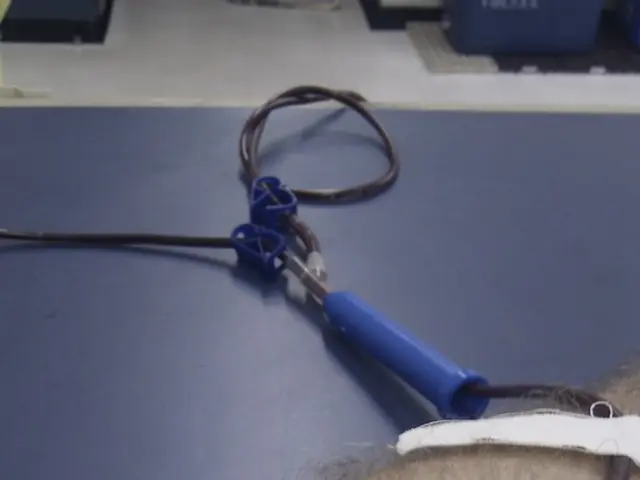Anticipated healing phases following hip replacement surgery: Understanding the procedure's progression
Hip replacement surgery recovery can be a unique and personal journey for each individual, but here's a lowdown on what you might expect:
Pre-surgery prep: Preparing for a hip replacement surgery is essential for a smooth recovery, and this can begin weeks before the big day. You'll want to discuss the procedure with your healthcare team, strengthen your legs, core, and upper body through exercises, maintain a moderate weight, and quit smoking (if possible). It's also wise to have help with daily tasks for a week or two following your return home after surgery, as well as prepared meals and home modifications like a raised toilet seat, safety bars, and mobility aids like a walker or crutches[1].
Immediate post-surgery: Following a partial or total hip replacement, you may remain in the hospital for 1 to 2 days, but some may go home on the same day as their surgery. In the days after the surgery, doctors will manage your pain through a mix of medications like opioids, local anesthetics, NSAIDs, and acetaminophen. Your surgeon will probably stitch or staple your incision, which might require at-home wound care. Expect healthcare professionals to encourage you to get up and move around as soon as possible, even on the same day of the operation[1].
Homecoming: Post-surgery, you may need assistance with daily tasks for a few weeks or even a stay in a rehabilitation facility. You may still experience some pain and discomfort for a few weeks and should continue taking any prescription medications. A physical therapist will advise you on exercises to aid your recovery and show you how to protect your new hip by moving and sitting correctly[1].
10 to 14 days post-surgery: By ten to fourteen days after the procedure, stitches or staples should be removed, and pain and swelling may start to diminish although not for everyone right away. Your level of activity may also vary between individuals[1].
Beyond two weeks: Within three to six weeks, many individuals can generally handle light activities of daily living. They may feel stronger, steadier, and more comfortable putting more weight on their leg and even able to perform basic self-care and light chores[1].
Returning to work: Most people feel ready to return to work after six weeks, but this can vary. After six to eight weeks, people may be able to engage in safe sexual activity[1].
Long-term recovery: Continue physical therapy as recommended for at least two months post-surgery. Talk to your doctor about when it is safe to engage in additional exercises like swimming and walking[1].
Factors affecting recovery: Recovery can vary depending on factors such as age and overall health[2]. Older adults may face more challenges due to compromised mobility, and they should prioritize avoiding falls to reduce the risk of requiring further surgery[2]. In contrast, modern implants have led to improved outcomes and survival rates in younger populations[2].
Hip resurfacing recovery: In hip resurfacing, the femoral head is trimmed and covered with a smooth metal cover rather than being removed. Most people can go home within 1 to 4 days after the procedure, and they may be able to begin putting weight on their leg immediately. You may require a walking aid like a walker, cane, or crutches for the first few days or weeks[3].
Risks and complications: Common long-term effects and restrictions following hip replacement surgery include some numbness, pain, or stiffness around the incision site, increased risk of falls or injuries during high impact sports, and the potential need for antibiotics before certain dental procedures[1].
• follow physical therapy exercises as a physical therapist instructs• try other gentle exercises, such as daily walking• sit in a reclining position• use a cold compress to reduce swelling• take any prescription medications as a doctor instructs• use walking aids, such as crutches, if necessary
Returning to normal activities: Typically, it takes several months for someone to resume heavy activities after hip replacement surgery[1]. It's vital to follow a personalized rehabilitation plan provided by your surgeon and physical therapist to ensure a safe return to activity[1].
- [1] "Hip Replacement Recovery - Time Table & What to Expect" retrieved 22/05/2023 from https://my.clevelandclinic.org/health/treatments/16800-hip-replacement/about/hip-replacement-rehabilitation
- [2] Layton, Hallie, "Hip Replacement for Younger People: Is it Safe and Effective?" retrieved 22/05/2023 from https://www.healthline.com/health/hip-replacement-younger-people
- [3] "Hip Resurfacing vs. Total Hip Replacement Recovery, Procedure, and Cost" retrieved 22/05/2023 from https://my.clevelandclinic.org/orthopedics-and-rheumatology/patient-care/orthopedic-procedures-and-surgeries/hip-resurfacing-vs-total-hip-replacement
- [4] "Returning to Work after Hip Replacement Surgery" retrieved 22/05/2023 from https://www.healthline.com/health/hip-replacement-return-to-work-timeline
- [5] "How long does it take to recover from a hip replacement?" retrieved 22/05/2023 from https://www.webmd.com/pain-management/back-pain/hip-replacement-recovery#1-5
• sitting still for long periods• crossing the legs at the knee• bending the hip more than 90 degrees• bending down to touch the feet or ankles• sitting in low chairs• intense exercise, which may involve jumping or sudden turns• moving or lifting heavy objects
- Managing chronic diseases like ulcerative colitis and Alzheimer's might require predictive science to establish a personalized treatment plan.
- Obesity is a significant factor that can exacerbate chronic kidney disease and cardiovascular health issues.
- Science has made remarkable strides in therapies and treatments for COPD, offering hope to many sufferers of this chronic respiratory disease.
- AQ (Atmospheric Quotient) research plays a crucial role in understanding and mitigating environmental factors linked to health and wellness, such as air pollution.
- CBD (Cannabidiol) is a promising compound in the field of mental health, with potential to aid in treating anxiety and depression.
- Fitness and exercise are essential components of health and wellness, contributing to the prevention and management of chronic diseases like cancer.
- Physical therapy is not only effective in hip replacement recovery, but it can also help manage various medical conditions like arthritis and obesity.
- Aging is a natural and inevitable process, yet it's essential to maintain cardiovascular health to support overall well-being as we age.
- Maintaining a moderate weight and quitting smoking can significantly improve recovery from hip replacement surgery and reduce the risk of future chronic diseases.
- Seeking professional help for mental health issues is just as important as physical health concerns, and treatments like cognitive-behavioral therapy can be effective in managing mental health conditions.








